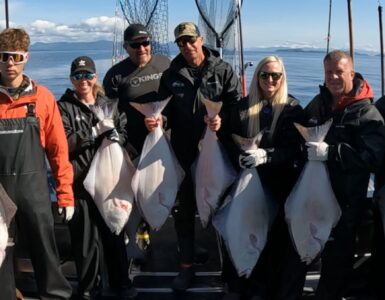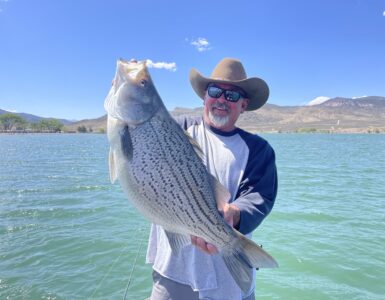Thanks for tuning into KSL Outdoors, I’m Adam Eakle along Pete Milburn from Sportsman’s Warehouse. Pete we were looking for just a quick fishing trip so we came up to Deer Creek and you said you found the walleye already. We’ve got the walleye, we’ve got them dialed in. It’s a great summer activity and a lot of people don’t know that really the best time to fish for walleye is in the summer. When they are actively feeding and they are hungry so, we came up here for a quick trip. What it’s fifty minutes from Salt Lake and you can have some great walleye fishing. Alright we are going to show you how to rig up and catch some fish, let’s do it.
We are going to be using a little swim bait today. This is a Sportsman’s Warehouse little swimbait we sell in the store relatively inexpensive, great product and it’s been deadly on these walleye this summer.
You can tip it with a night crawler, piece of nightcrawler, whatever. But I like just to spray it with a little bit of this crawfish Bang.
Alright give me one of those, we’ll try it. Now I’ve got to put that spray on to I guess huh? Yes you do, now another thing is believe it or not, don’t rig it straight, rig it through the side like it’s wounded. Really? Instead of going through the top, just come through, down a little bit and through the side just like this so it’s kind of laying sideways on there. Makes it look like it’s wounded. Which walleye can’t resist a wounded minnow, they are going to eat it every time.
You just cast it out let it sink little bit. Make sure it’s getting down to the bottom. You want to use a 1/4 ounce jig head, probably 3/16 or 1/4 ounce jig head.
Let it sink a little bit, get your line tight and then you want to pop it and let it sink back down to the bottom and pop it. Because what walleye do when they feed is they’ll swim through weeds and brush and try and spook up minnows and scare them and so there is minnows that dart up off the bottom and that’s what you are trying to mimic is the minnow being spooked by the walleye darting up off the bottom and the walleye will come pick that up.
Oh did you see that one kill it? Get him? Yup. Nice.
Absolute clobbered it. Looks like a pretty good fish. Better than the little tike I caught. Feels pretty good we’ll see. Oh yeah, that’s mister walleye. He’s oh..he’s a frisk… I tell you it’s the oxygen level. The wind kicks up, that oxygen level increases. Was he right near the bottom. I’ll tell you what he clobbered it. Want the net? Nice fish. That’s a good eater. That’s a better one.
It’s really important to get that pop in there. That one clobbered it. When this wind kicks up, you get that oxygen level up and they move right in here. It refracts the light. Light conditions change underneath the surface and bam we are in business.
There’s a fish. Awesome.
Little smallmouth. It’s not a walleye. We don’t want no stinking smallmouth.
That’s alright, a fish is a fish.
There we go. That’s a walleye too. There’s a fish.
Walleye! Little guy, he’s an eater though.
Maybe the bite is just getting going huh? Yeah it’s been an afternoon thing.
We’ll have some walleye fish tacos tonight.
You can catch these fish all day. Also if you look at the moon phase a lot of times, if the moon is up in the early evening. They’ll feed in the evening but come about noon o’clock, they start to get hungry again so that’s a good time to get out there on the water.
Nice. There’s another walleye! You dog!
Why do you think this works so well right now with this size of swim bait. Do you think there is a lot of minnows right now that are this size. There is all kinds of minnows in here you know because you’ve got the smallmouth, largemouth spawn, you’ve got the walleye spawn, the perch have spawned. Yea. So there is all kinds of different sized minnows anywhere from, you know, bitty fry to you know, pretty good sized bass by now.
Yeah we may have to do some bottom bouncing. Cuz people that don’t have the touch with the jig like to bottom bounce. Yeah like me. We’ll take Adam bottom bouncing. All I’ve caught is smallmouth with this technique so far. You want me to hook this on your jig. Yeah would you please.
So the jig worked and Pete you caught four or five I guess. Yeah I caught five. I think I caught zero! But I did catch some smallmouth. It is a difficult technique to get down, you can come out and do it.
Mister walleye welcome aboard.
There we go. You know bottom bouncing is probably my favorite way to find walleye. It’s not the easiest. That’s right. It is the easiest. It is the easiest once you learn, so we are going to show you how to do it. Welcome back to KSL Outdoors and we are back in the eyes.
What I use bottom bouncing for like I said earlier is searching. Mmm Hmmm. I use them to search to find where the fish are, what they kind of want to eat. Sure.
It’s really critical that you skip the bottom when you are doing this. If it’s not on the bottom, you are not catching fish. You’re not going to catch them. So I’m going to use a perch fire tiger color. Adam you are using that silly pink.
Trolling bottom bouncing rigs is a great way to catch walleye, especially in the summer. Here are a few things to keep in mind. Make sure to use a heavy enough weight to stay on the bottom for the speed you are trolling. A slower speed will allow you to use a lighter weight. A faster trolling speed will require a heavier weight. I usually like to troll about one mile per hour. Make sure to let out enough line so you can get the line down to the bottom. If you’re not bouncing the bottom, you’re not catching fish. Spinner rigs work well with bottom bouncers. Green, chartreuse, orange and glow in the dark colors work really well. Nightcrawlers, and minnows is what I usually tip my spinner rigs with.
It’s a walleye. Little guy. Boy that was a long time to catch that fish. There are in there. I think they’re in their spot.
With a nightcrawler. Nice eye. Ok I couldn’t get the jig thing down, but I literally bottom bounced for what? 30 seconds? 30 seconds. If that? And we got an eye, so. I’m a bottom bouncer.
Oh got one. You got one? Mmm hmm. Good one too.
That’s a good eye is what that is. Holy crud! Dude that’s a… that’s a good… do you want the net. That’s a fighter! She’s a fighter captain. That’s a nice one. Where’s the net?
Oh yeah he’s good. That’s a fighting little bugger. Nice fish. That’s as good as that first one you caught.
1,2,3,4, 5.
Now sometimes when the walleye bite, you gotta’ let a … you’ve got to do what my buddy Brad and Ray say, you feed it to them, just give it to them a little bit and then once they have it, like right there! Oh I missed him. Then you sweep forward when you set the hook. You don’t set the hook like a trout hook, you just sweep forward and like Pete was saying a lot of times, they’ll hook themselves this way.
Ok, getting bit, getting bit, feed it too him. He’s there. Sweep it forward, there he is. It’s a wally, doesn’t feel real big, but that is definitely a walleye.
Oh yeah nice fish. Want the net? I think I’ve got him. He’s lipped pretty good.
Finding feeding walleye is sometimes the hardest part of walleye fishing. That’s why I believe trolling a bottom bouncing rig is so effective. You cover a lot of water and once you do pick up a walleye or two, you can switch to jigs or even swimbaits like Pete showed us and target them in a smaller area where you know there are more walleye. Another good one. Who brought this guy! Who let him on the boat? What did I say about summer walleye fishing? I know it’s on fire.
Welcome back to KSL Outdoors, I’m Jared Hargrave. Well, we’ve moved up to Box Elder County, and we’re going to try to capture the Short-Eared Owl. The reason we’re going to do this is because there’s not a whole lot known about how the bird moves through the state of Utah. So Hawkwatch International, along with the DNR and the Tracy Aviary, are going to capture one, put a GPS on it, so they can figure out where it goes. Let’s go see if we can catch one. Today we’re out trying to catch some short-eared owls. And put some small backpack tracking units on the birds that will give us GPS coordinates for where the birds are located after we let them go. Oh, there we go. Yea, there’s another one right there. Neil Poprocki is a Conservation Biologist with Hawkwatch International. He’s tracking these owls in partnership with the University of Utah. They supplied us with the transmitters. To learn more about this unique bird. This is a species that’s very understudied. Um, we don’t know that much about their movements. The other thing in kind of the larger context of this project, is that short eared owl populations are declining across North America. There’s a bunch of whitewash on the perch. The leading suspected cause of decline is habitat loss. Particularly the loss of grassland habitats. But there are probably other factors. This is a short eared owl. You can tell by the feet. Collisions with vehicles. Colliding with barb wire fences and getting entangled. And then also probably predation, due to ground predators. So just trying to get a better understanding of, of really a lot of different things because there’s a lot that we don’t know. So the mouse goes in here. Tonight, they’re catching owls with a bal chrati trap, a small, metal cage that they put mice in as bait. The idea is that the owl tries to come down, and it tries to get the mice, and it tries to fly away and its, its feet get get caught. And these nooses are just made out of fishing line. Traps at the ready, we drive around until we see an owl on its perch. And the trap is set. All we can do now, is wait. Okay, come on. He looked at it. He was looking at it. But these owls, they don’t want to cooperate. Usually around 5pm, you’ll start to see them come up and start hunting. Which is nice for us trying to catch them. We don’t have necessarily have to stay up all night trying to catch them, we can catch them when it’s light out. But the sun is going down, when dozens of short eared owls take flight. There’s so much activity. Oh my word. Them an owl finally lands on the trap. So we just caught an owl. The problem, is that they caught a fledgling bird, that can’t be fitted with a transmitter. The females have this kind of darker facial disk that thew young birds have. So they band it. We want the band to spin freely. Measure the wing. Two hundred and eighty six millimeters. The tail. Maybe one forty seven. And weigh the bird. Three hundred and twelve grams. You’re flapping around a whole bunch. And you’re probably not eating as much. So hopefully it can still provide valuable data. We don’t know the birds that breed here, we don’t know where they go to winter, we don’t know where they migrate, we don’t know if they come back here to breed again in subsequent years, or if they go elsewhere. So we don’t know a lot about their basic movement patterns, so that’s one thing we’re trying to figure out. There he goes. How cool is that? The short eared owl. Hopefully, uh, biologists will learn a lot from this project on their populations here in Utah, yeah? Yeah, yeah, for sure. It’s nice to catch a young bird like this and find out a little bit more about what kind of sizes they are and yeah, hopefully this guy lives a while.







Add comment